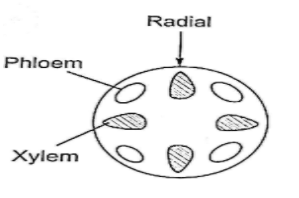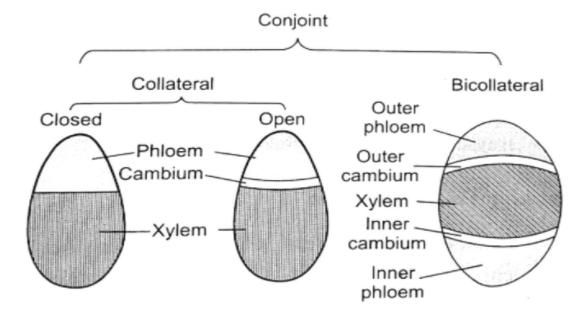
Explain the vascular tissue system
Answer
492.6k+ views
Hint:Water and dissolved minerals are transported from the roots to the entire plant. Leaves prepare food which is transported to the entire plant. Thus conduction tissues are needed and these together function like a unit.
Complete answer:
There are various types of tissues seen in plants. These tissues work together as a unit to form many tissue systems,
Depending on structure and location, there are three types of tissue systems in plants:
>Epidermal Tissue system
>Ground or Fundamental Tissue system
>Vascular or Conducting Tissue system
The Vascular bundles are classified into the following types
On the basis of presence or absence of Cambium, the vascular bundles are open or closed type
Open vascular bundle: Cambium is present between Xylem and Phloem and such a bundle is an open vascular bundle. Due to the presence of cambium, the xylem and phloem can form secondary xylem and phloem also. This means the vascular bundles are ‘open’ to growth. This is seen in Dicotyledonous stems.
Closed vascular bundle: Cambium is absent in this type. Thus secondary growth is not seen. This is seen in Monocot stems, leaves of dicots and monocots.
On the basis of relative positions of xylem and phloem, the bundles are classified as
1) Radial:
The Xylem and Phloem are arranged alternately along the different radii. Such vascular bundles are seen in the roots of dicots and monocots.
2) Conjoint:
When Xylem and Phloem are jointly situated along the same radius, the arrangement is known as conjoint. This further can be open or closed type depending on the presence or absence of cambium. It is seen that the phloem is located on the outer side of xylem. The third type is bicollateral. In this phloem occurs on both outer and inner sides of the xylem.

The diagram below shows three types of conjoint vascular bundles

Additional information:
1) Epidermal Tissue system
>This tissue system forms the outermost covering of the plant body. It is in direct contact with the environment. This system comprises of
Epidermal cells
>Epidermal structures i.e. Stomata
>Epidermal appendages i.e.hairs and trichomes
Functions of the Epidermal tissue system
>Protection
>Gaseous exchange
>Secretion
>Absorption of water and minerals
2) Ground or Fundamental Tissue system
This tissue system forms the main bulk of the plant body. It includes parenchyma, collenchyma and sclerenchyma. It includes Cortex, Pericycle and Pith. Cortex includes hypodermis and endodermis.
Note:There is one more arrangement of vascular bundles and it is known as Concentric Vascular bundle. In this type, either phloem surrounds the xylem or xylem surrounds the phloem.
Thus there are two types:
Amphivasal or Leptocentric: Xylem surrounds the phloem (Lepto is phloem)
Amphicribal or Androcentric: Phloem surrounds the xylem (Hydro is water i.e. related to xylem which is in the centre)
There is one more arrangement of vascular bundles and it is known as Concentric Vascular bundle. In this type, either phloem surrounds the xylem or xylem surrounds the phloem. Thus there are two types:
Amphivasal or Leptocentric: Xylem surrounds the phloem (Lepto is phloem)
Amphicribal or Androcentric: Phloem surrounds the xylem (Hydro is water i.e. related to xylem which is in the centre)
Complete answer:
There are various types of tissues seen in plants. These tissues work together as a unit to form many tissue systems,
Depending on structure and location, there are three types of tissue systems in plants:
>Epidermal Tissue system
>Ground or Fundamental Tissue system
>Vascular or Conducting Tissue system
The Vascular bundles are classified into the following types
On the basis of presence or absence of Cambium, the vascular bundles are open or closed type
Open vascular bundle: Cambium is present between Xylem and Phloem and such a bundle is an open vascular bundle. Due to the presence of cambium, the xylem and phloem can form secondary xylem and phloem also. This means the vascular bundles are ‘open’ to growth. This is seen in Dicotyledonous stems.
Closed vascular bundle: Cambium is absent in this type. Thus secondary growth is not seen. This is seen in Monocot stems, leaves of dicots and monocots.
On the basis of relative positions of xylem and phloem, the bundles are classified as
1) Radial:
The Xylem and Phloem are arranged alternately along the different radii. Such vascular bundles are seen in the roots of dicots and monocots.
2) Conjoint:
When Xylem and Phloem are jointly situated along the same radius, the arrangement is known as conjoint. This further can be open or closed type depending on the presence or absence of cambium. It is seen that the phloem is located on the outer side of xylem. The third type is bicollateral. In this phloem occurs on both outer and inner sides of the xylem.

The diagram below shows three types of conjoint vascular bundles

Additional information:
1) Epidermal Tissue system
>This tissue system forms the outermost covering of the plant body. It is in direct contact with the environment. This system comprises of
Epidermal cells
>Epidermal structures i.e. Stomata
>Epidermal appendages i.e.hairs and trichomes
Functions of the Epidermal tissue system
>Protection
>Gaseous exchange
>Secretion
>Absorption of water and minerals
2) Ground or Fundamental Tissue system
This tissue system forms the main bulk of the plant body. It includes parenchyma, collenchyma and sclerenchyma. It includes Cortex, Pericycle and Pith. Cortex includes hypodermis and endodermis.
Note:There is one more arrangement of vascular bundles and it is known as Concentric Vascular bundle. In this type, either phloem surrounds the xylem or xylem surrounds the phloem.
Thus there are two types:
Amphivasal or Leptocentric: Xylem surrounds the phloem (Lepto is phloem)
Amphicribal or Androcentric: Phloem surrounds the xylem (Hydro is water i.e. related to xylem which is in the centre)
There is one more arrangement of vascular bundles and it is known as Concentric Vascular bundle. In this type, either phloem surrounds the xylem or xylem surrounds the phloem. Thus there are two types:
Amphivasal or Leptocentric: Xylem surrounds the phloem (Lepto is phloem)
Amphicribal or Androcentric: Phloem surrounds the xylem (Hydro is water i.e. related to xylem which is in the centre)
Recently Updated Pages
The correct geometry and hybridization for XeF4 are class 11 chemistry CBSE

Water softening by Clarks process uses ACalcium bicarbonate class 11 chemistry CBSE

With reference to graphite and diamond which of the class 11 chemistry CBSE

A certain household has consumed 250 units of energy class 11 physics CBSE

The lightest metal known is A beryllium B lithium C class 11 chemistry CBSE

What is the formula mass of the iodine molecule class 11 chemistry CBSE

Trending doubts
Describe the effects of the Second World War class 11 social science CBSE

Which of the following methods is suitable for preventing class 11 chemistry CBSE

Proton was discovered by A Thomson B Rutherford C Chadwick class 11 chemistry CBSE

Why do you think did the narrator call lie Amsterdam class 11 english CBSE

Tentacles of Hydra are A Hollow B Solid C Half hollow class 11 biology CBSE

What do you mean by public facilities




